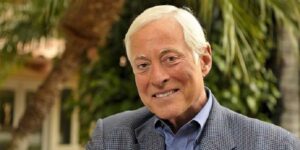Dave Ulrich biografie en boeken

Dave Ulrich (1953) is the Rensis Likert Professor of Business aan de Ross School, University of Michigan en partner bij de RBL Group. Dave Ulrich is ook de grondlegger van het Four-Role-model, een HR transformatiemodel en het Leadership Capital Index, een raamwerk van leiderschapsfactoren.
Dave Ulrich biografie
Dave Ulrich is de Rensis Likert Professor of Business aan de Ross School, University of Michigan en partner bij de RBL Group (http://www.rbl.net), een adviesbureau dat zich richt op het helpen van organisaties en leiders om waarde te creëren. Hij heeft meer dan 200 artikelen en bijdragen voor boeken gepubliceerd en meer dan 30 boeken uitgegeven.
Hij redigeerde Human resource Management 1990-1999, was lid van de redactie van 4 tijdschriften, zat in de Raad van Bestuur van Herman Miller (16 jaar) en de Board of Trustees van de Southern Virginia University, heeft in 90 landen voor een groot publiek gesproken; workshops gegeven voor meer dan de helft van de Fortune 200; coachte succesvolle bedrijfsleiders en is fellow van de National Academy of Human Resources.
Hij staat bekend om zijn voortdurende wil om te leren, het omzetten van complexe ideeën in eenvoudige oplossingen en het creëren van echte waarde voor degenen met wie hij samenwerkt op drie gebieden.
Organisatie
Met co-autheurs heeft hij het denken over organisaties beïnvloed (Reinventing the Organization) door empirisch te laten zien hoe goede organisatie vier keer zoveel bedrijfsresultaten oplevert dan talent (Victory Through Organization), door organisaties te definiëren als bundels van mogelijkheden (Organization Capability) en door te werken aan het afbakenen van mogelijkheden van talent management (Why of Work; Talent Accelerator), cultuurverandering (GE Workout), leren (Learning Organization Capability), en samenwerking (Boundaryless Organization).
Leiderschap
Samen met collega’s heeft hij ook de basisbeginselen van effectief leiderschap onder woorden gebracht, (Leadership Code en Results Based Leadership), leiderschap gekoppeld aan klanten (Leadership Brand), aangetoond hoe leiderschap marktwaarde levert (Why the Bottom Line Isn’t), verwachtingen van investeerders en het vermogen om leiderschap te meten gevormd (Leadership Capital Index), en manieren gesynthetiseerd om ervoor te zorgen dat leiderschapsambities worden omgezet in acties (Leadership Sustainability).
Human Resources
Hij en zijn collega’s hebben het HR-beroep gevormd en hij wordt de “vader van moderne HR” en “HR-gedachteleider van het decennium” genoemd, omdat hij zich concentreerde op HR-resultaten, -governance, -competenties en -praktijken.
Hij bracht een cadeau-boek uit over de toekomst van HR met de titel The Rise of HR, verspreid onder meer dan 1.500.000 Hr-professionals), waarin 70 opinieleiders vrijelijk hun inzichten delen.
Dave Ulrich quotes
- “When desperate people seek easy solutions without doing the hard work of fundamental learning and change, resilience is undermined and real growth and learning fade.”
- “HR professionals play three roles: Storyteller, Strategy interpreter and Strategic facilitator.”
- “Often the hands will solve a mystery that the intellect has struggled with in vain.”
- “Improving the skills of HR colleagues. The best learners are also teachers. Investing in building the skills of HR colleagues requires individuals to be clear and disciplined about a topical area, tool, or technology.”
- “As the pace of change increases in every aspect of our lives, HR professionals have become change champions in many companies around the world, and this has generally been much to their employers’ advantage.”
- “domain in which HR tends to be the weakest is in understanding and applying technology to build HR.”
- “Competencies can be communicated—and therefore can be taught and learned.”
- “Connecting people though technology, Aligning strategy, culture, practices, and behavior and Sustaining change”
- “look backward for answers to future problems may be left behind.”
- “culture is not only norms, behaviors, and values, but the norms, behaviors, and values that will induce targeted customers to have a more intense relationship with the firm.”
Boeken en publicaties
- 2019. Agility: The new response to dynamic change. Strategic HR Review.
- 2019. Reinventing the organization: How companies can deliver radically greater value in fast-changing markets. Harvard Business Press.
- 2018. Building a world class HR department. Strategic HR Review.
- 2017. Competencies for HR professionals who deliver outcomes.
- 2017. Rise of HR—New mandates for IO. Industrial and Organizational Psychology, 10(1), 3-25.
- 2017. Leaders as paradox navigators. Leader to Leader, 2017(86), 53-59.
- 2015. The boundaryless organization: Breaking the chains of organizational structure. John Wiley & Sons Inc.
- 2015. Are we there yet? What’s next for HR?. Human Resource Management Review, 25(2), 188-204.
- 2015. Learning from practice: how HR analytics avoids being a management fad. Organizational Dynamics, 44(3), 236-242.
- 2013. The state of the HR profession. Human Resource Management, 52(3), 457-471.
- 2012. What is leadership. Advances in global leadership, 7(1), 9-36.
- 2012. HR talent and the new HR competencies. Strategic HR Review.
- 2012. What is talent?. Leader to leader, 2012(63), 55-61.
- 2012. Best practices in leadership development and organization change: how the best companies ensure meaningful change and sustainable leadership (Vol. 18). John Wiley & Sons.
- 2010. The why of work. Tata McGraw-Hill Education.
- 2009. The role of strategy architect in the strategic HR organization. People & Strategy, 32(1), 24-32.
- 2009. HR transformation: Building human resources from the outside in. New York.
- 2009. The leadership code: five rules to lead by. Harvard Business Press.
- 2008. The twenty‐first‐century HR organization. Human Resource Management, 47(4), 829-850.
- 2007. The future of human resource management: 64 thought leaders explore the critical HR issues of today and tomorrow. John Wiley & Sons.
- 2007. Human resource competencies: Responding to increased expectations.
- 2007. Building a leadership brand. Harvard Business Review, 85(7/8), 92.
- 2005. HR’s new ROI: Return on intangibles. Human Resource Management: Published in Cooperation with the School of Business Administration, The University of Michigan and in alliance with the Society of Human Resources Management, 44(2), 137-142.
- 2004. Human resources business process outsourcing: Transforming how HR gets its work done. John Wiley & Sons.
- 2004. Capitalizing on capabilities. Harvard business review, 119-128.
- 2003. Why the bottom line isn’t!: How to build value through people and organization. John Wiley & Sons.
- 2002. How to implement GEs revolutionary method for busing bureaucracy and attacking organizational problems fast. Two Penn Plaza, NY: McGraw-Hill.
- 2002. The boundaryless organization. Facilities.
- 2001. From partners to players: Extending the HR playing field. Human Resource Management: Published in Cooperation with the School of Business Administration, The University of Michigan and in alliance with the Society of Human Resources Management, 40(4), 293-307.
- 2001. The HR Scorecard: Linking People. Strategy and Performance, Harvard Business School Press, Boston, MA, 353.
- 2000. Leveraging leadership competencies to produce leadership brand: Creating distinctiveness by focusing on strategy and results. Human Resource Planning, 23(3), 12-23.
- 2000. From eBusiness to eHR. People and Strategy, 23(2), 12.
- 2000. The new leadership development. Training & Development, 54(3), 22-22.
- 1998. Intellectual capital= competence x commitment. MIT Sloan Management Review, 39(2), 15.
- 1998. A new mandate for human resources. Harvard business review, 76, 124-135.
- 1997. Human Resource Champions: The next agenda for adding value and delivery results. Harvard Business School Press. Retrieved July, 23, 2007.
- 1997. Measuring human resources: an overview of practice and a prescription for results. Human Resource Management: Published in Cooperation with the School of Business Administration, The University of Michigan and in alliance with the Society of Human Resources Management, 36(3), 303-320.
- 1997. HR of the future: Conclusions and observations.
- 1996. Human resource roles: Creating value, not rhetoric. People and Strategy, 19(3), 38.
- 1995. Human resource competencies: An empirical assessment. Human resource management, 34(4), 473-495.
- 1995. Shared services: From vogue to value. People and Strategy, 18(3), 12.
- 1993. Profiling organizational competitiveness: Cultivating capabilities. People and Strategy, 16(3), 1.
- 1991. Organizational capability: Creating competitive advantage. Academy of Management Perspectives, 5(1), 77-92.
- 1991. Employee and customer attachment: synergies for competitive. People and Strategy, 14(2), 89.
- 1991. Using human resources for competitive advantage. Making organizations competitive, 129-155.
- 1990. General organizational classification: An empirical test using the United States and Japanese electronics industries. Organization Science, 1(1), 99-118.
- 1990. Organizational capability: Competing from the inside out. John Wiley & Sons.
- 1989. Tie the corporate knot: Gaining complete customer commitment. MIT Sloan Management Review, 30(4), 19.
- 1989. Assessing human resource effectiveness: Stakeholder, utility, and relationship approaches. People and Strategy, 12(4), 301.
- 1989. Beyond belief: A benchmark for human resources. Human Resource Management, 28(3), 311-335.
- 1987). Strategic human resource planning: why and how?. People and Strategy, 10(1), 37.
- 1987. Organizational capability as a competitive advantage: Human. People and Strategy, 10(4), 169.
- 1984. Design strategy from the population perspective. Journal of Management, 10(1), 67-86.
Citatie voor dit artikel:
Janse, B. (2021). Dave Ulrich. Retrieved [insert date] from Toolshero: https://www.toolshero.nl/bekende-auteurs/dave-ulrich/
Oorspronkelijke publicatiedatum: 14/01/2021 | Laatste update: 16/05/2023
Wilt u linken naar dit artikel, dat kan!
<a href=”https://www.toolshero.nl/bekende-auteurs/dave-ulrich/”>Toolshero: Dave Ulrich</a>












